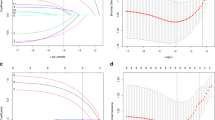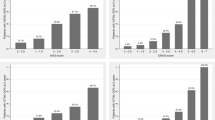Abstract
Purpose
Suboptimal response is one of the major problems for bariatric surgery, and constructing an individualized model for predicting outcomes of bariatric surgery is essential. Thus, the aim of this study is to develop a nomogram to predict the response to bariatric surgery.
Materials and Methods
509 patients who underwent bariatric surgery between 2019 to 2020 from 6 centers were retrieved and assessed. Multiple Imputation was used to replace missing data. Patients with %TWL ≥ 20% 1 year after bariatric surgery were classified as patients with optimal response, while the others were patients with suboptimal response. A web-based nomogram was constructed and validated. ROC curve and calibration curve were used to determine the predictive ability of our model.
Results
56 (11.0%) patients were classified as patients with suboptimal response, and they showed advanced age, lower pre-operative BMI, smaller waist circumference, higher fasting glucose, higher HbA1c and lower fasting insulin compared to patients with optimal response. A forward likelihood ratio logistic regression analysis indicated that age (OR = 0.943, 95% CI: 0.915–0.971, p < 0.001), pre-operative BMI (OR = 1.109, 95% CI: 1.002–1.228, p = 0.046) and waist circumference (OR = 1.043, 95% CI: 1.000–1.088, p = 0.048) were essential factors contributing to the response to bariatric surgery. Lastly, a web-based nomogram was constructed to predict the response to bariatric surgery and demonstrated an AUC of 0.829 and 0.798 upon internal and external validation.
Conclusion
Age, BMI and fasting glucose were proved to be essential factors influencing the response to bariatric surgery. The nomogram constructed in this study demonstrated good adaptivity.
Graphical Abstract



Similar content being viewed by others
Data Availability
The data that support the findings of this study are available from the corresponding author, Prof. Junjiang Wang, upon reasonable request.
References
Ogden CL, Fryar CD, Martin CB, et al. Trends in obesity prevalence by race and hispanic origin-1999-2000 to 2017–2018. JAMA. 2020;324:1208–10.
Ellison-Barnes A, Johnson S, Gudzune K. Trends in obesity prevalence among adults aged 18 through 25 years, 1976–2018. JAMA. 2021;326:2073–4.
Ward ZJ, Bleich SN, Cradock AL, et al. Projected U.S. state-level prevalence of adult obesity and severe obesity. N Engl J Med. 2019;381:2440–50.
GBD 2015 Obesity Collaborators, Afshin A, Forouzanfar MH, et al. Health effects of overweight and obesity in 195 countries over 25 years. N Engl J Med. 2017;377:13–27.
Okunogbe A, Nugent R, Spencer G, et al. Economic impacts of overweight and obesity: current and future estimates for 161 countries. BMJ Glob Health. 2022;7:e009773.
Gadde KM, Martin CK, Berthoud H-R, et al. Obesity: pathophysiology and management. J Am Coll Cardiol. 2018;71:69–84.
Nguyen NT, Varela JE. Bariatric surgery for obesity and metabolic disorders: state of the art. Nat Rev Gastroenterol Hepatol. 2017;14:160–9.
Arterburn DE, Telem DA, Kushner RF, et al. Benefits and risks of bariatric surgery in adults: a review. JAMA. 2020;324:879–87.
El Ansari W, Elhag W. Weight regain and insufficient weight loss after bariatric surgery: definitions, prevalence, mechanisms, predictors, prevention and management strategies, and knowledge Gaps-a scoping review. Obes Surg. 2021;31:1755–66.
Eisenberg D, Shikora SA, Aarts E, et al. American Society for Metabolic and Bariatric Surgery (ASMBS) and International Federation for the Surgery of Obesity and Metabolic Disorders (IFSO): indications for metabolic and bariatric surgery. Surg Obes Relat Dis. 2022;2022:S1550728922006414.
Zou S, Yang C, Shen R, et al. Association between the triglyceride-glucose index and the incidence of diabetes in people with different phenotypes of obesity: a retrospective study. Front Endocrinol (Lausanne). 2021;12:784616.
Ozmen MM, Guldogan CE, Gundogdu E. Changes in HOMA-IR index levels after bariatric surgery: Comparison of Single Anastomosis Duodenal Switch-proximal approach (SADS-p) and One Anastomosis Gastric Bypass-Mini Gastric Bypass (OAGB-MGB). Int J Surg. 2020;78:36–41.
Luo P, Cao Y, Li P, et al. Insulin resistance remission following laparoscopic Roux-en-Y Gastric bypass and laparoscopic sleeve gastrectomy in Chinese type 2 diabetes mellitus patients with a body mass index of 27.5-32.5 kg/m2. Front Physiol. 2021;12:772577.
Grover BT, Morell MC, Kothari SN, et al. Defining weight loss after bariatric surgery: a call for standardization. Obes Surg. 2019;29:3493–9.
Zhang L, Cui H, Chen Q, et al. A web-based dynamic Nomogram for predicting instrumental activities of daily living disability in older adults: a nationally representative survey in China. BMC Geriatr. 2021;21:311.
Blume CA, Brust-Renck PG, Rocha MK, et al. Development and validation of a predictive model of success in bariatric surgery. Obes Surg. 2021;31:1030–7.
Gutiérrez-Repiso C, Garrido-Sánchez L, Alcaide-Torres J, et al. Predictive role of gut microbiota in weight loss achievement after bariatric surgery. J Am Coll Surg. 2022;234:861–71.
Tu Y, Pan Y, Han J, et al. A total weight loss of 25% shows better predictivity in evaluating the efficiency of bariatric surgery. Int J Obes (Lond). 2021;45:396–403.
Barthold D, Brouwer E, Barton LJ, et al. Minimum threshold of bariatric surgical weight loss for initial diabetes remission. Diabetes Care. 2022;45:92–9.
Brethauer SA, Kim J, El Chaar M, et al. Standardized outcomes reporting in metabolic and bariatric surgery. Obes Surg. 2015;25:587–606.
van Rijswijk A-S, van Olst N, Schats W, et al. What is weight loss after bariatric surgery expressed in percentage total weight loss (%TWL)? A systematic review. Obes Surg. 2021;31:3833–47.
Tu Y, Bao Y, Zhang P. Metabolic surgery in China: present and future. J Mol Cell Biol. 2021;13:594–609.
Belligoli A, Bettini S, Segato G, et al. Predicting responses to bariatric and metabolic surgery. Curr Obes Rep. 2020;9:373–9.
de Raaff CAL, Coblijn UK, de Vries N, et al. Predictive factors for insufficient weight loss after bariatric surgery: does obstructive sleep apnea influence weight loss? Obes Surg. 2016;26:1048–56.
Yarigholi F, Bahardoust M, Mosavari H, et al. Predictors of weight regain and insufficient weight loss according to different definitions after sleeve gastrectomy: a retrospective analytical study. Obes Surg. 2022;32:4040–6.
Zhao J, Jiang Y, Qian J, et al. A nomogram model based on the combination of the systemic immune-inflammation index and prognostic nutritional index predicts weight regain after laparoscopic sleeve gastrectomy. Surg Obes Relat Dis. 2023;19:50–8.
Bioletto F, Pellegrini M, D’Eusebio C, et al. Development and validation of a scoring system for pre-surgical and early post-surgical prediction of bariatric surgery unsuccess at 2 years. Sci Rep. 2021;11:21067.
Mao R, Guo P, Lin Z, et al. Nomograms for predicting non-remission in patients who underwent bariatric surgery: a multicenter retrospective study in China. Obes Surg. 2021;31:1967–78.
Tettero OM, Monpellier VM, Janssen IMC, et al. Early postoperative weight loss predicts weight loss up to 5 years after Roux-En-Y gastric bypass, banded Roux-En-Y gastric bypass, and sleeve gastrectomy. Obes Surg. 2022;32:2891–902.
Su Y-T, Su Y-H, Tam K-W, et al. Prediction of 5-Year weight loss and weight regain according to early weight loss after sleeve gastrectomy. Obes Surg. 2023;33:1366–72.
Funding
This study was funded by National key Clinical Specialty Construction Project (2021–2024, No. 2022YW030009) and Bethune-Merck Research Fund for young surgeons (2021).
Author information
Authors and Affiliations
Corresponding authors
Ethics declarations
Ethical Approval
All procedures performed in studies involving human participants were in accordance with the ethical standards of the institutional and/or national ethics committee (KY2023-123–02) and with the 1964 Helsinki declaration and its later amendments or comparable ethical standards.
Informed Consent
Informed consent was obtained from all individual participants included in the study.
Conflict of Interest
The authors declare that they have no conflict of interest.
Additional information
Publisher's Note
Springer Nature remains neutral with regard to jurisdictional claims in published maps and institutional affiliations.
Key Points
1. Patients with suboptimal response showed advanced age, lower BMI, smaller waist circumference, lower fasting insulin and higher fasting glucose and HbA1c before receiving bariatric surgery, compared to those patients with great response.
2. Age, pre-operative BMI and waist circumference were important characters that may contribute to the response after receiving bariatric surgery.
3. A web-based dynamic nomogram, which could help make clinical decisions, were constructed and showed predictive accuracy and discriminative ability.
Supplementary Information
Below is the link to the electronic supplementary material.
Rights and permissions
Springer Nature or its licensor (e.g. a society or other partner) holds exclusive rights to this article under a publishing agreement with the author(s) or other rightsholder(s); author self-archiving of the accepted manuscript version of this article is solely governed by the terms of such publishing agreement and applicable law.
About this article
Cite this article
Diao, W., Chen, Y., Liang, L. et al. Constructing and Validating a Dynamic Nomogram to Predict Response to Bariatric Surgery: A Multicenter Retrospective Study. OBES SURG 33, 2898–2905 (2023). https://doi.org/10.1007/s11695-023-06729-6
Received:
Revised:
Accepted:
Published:
Issue Date:
DOI: https://doi.org/10.1007/s11695-023-06729-6




